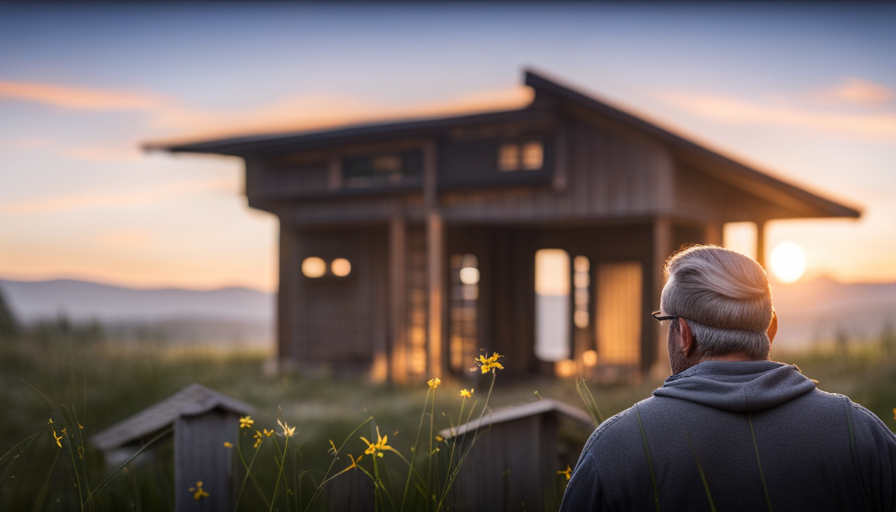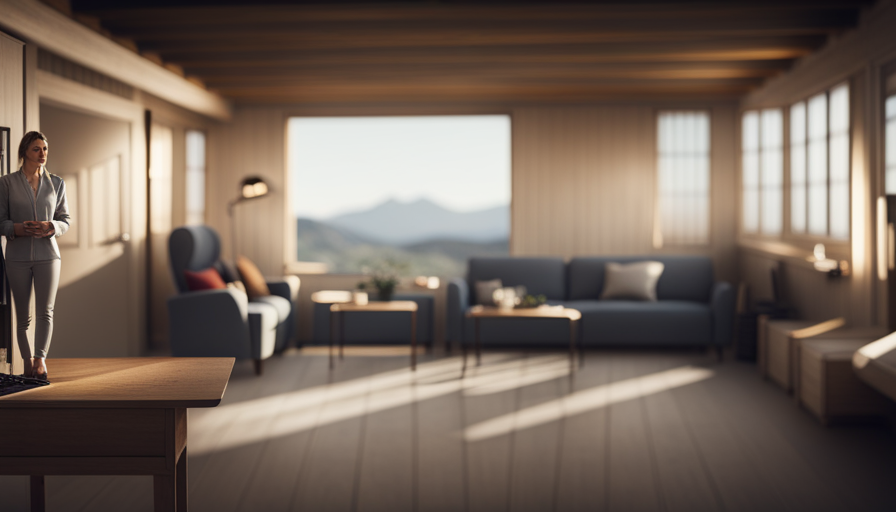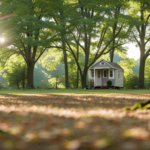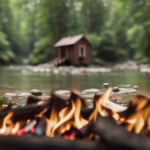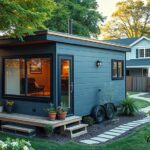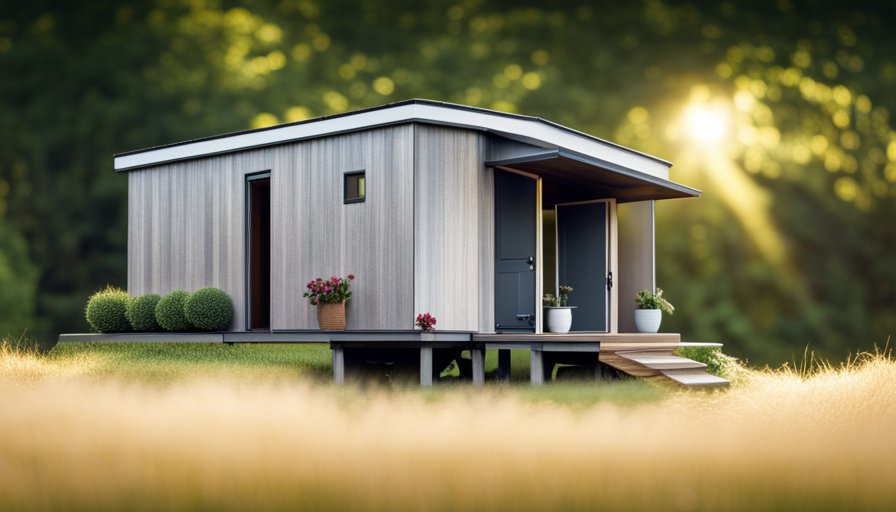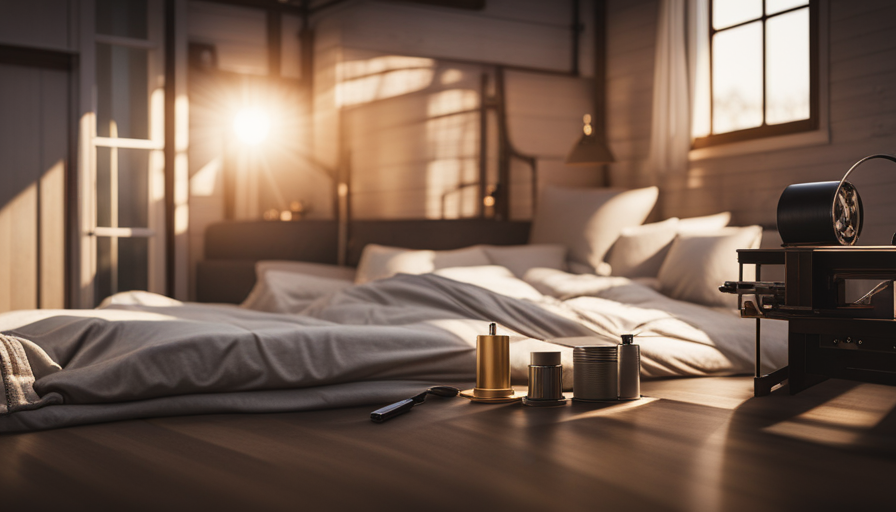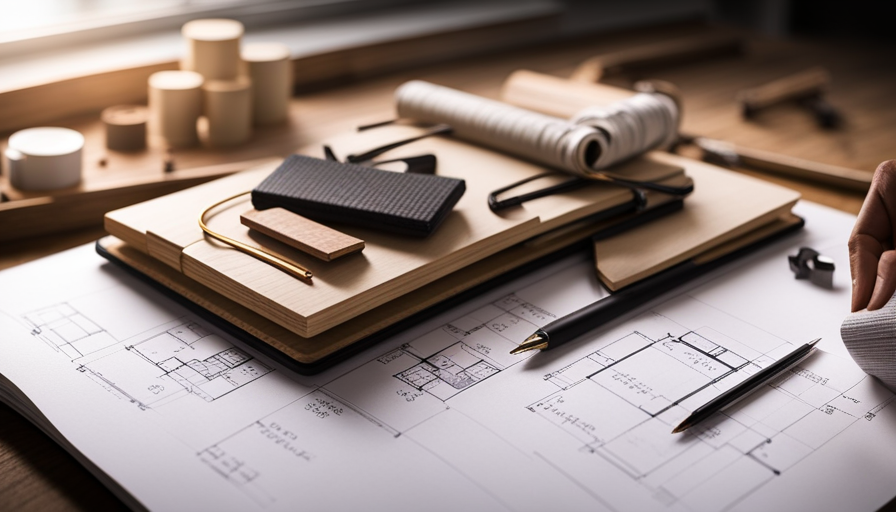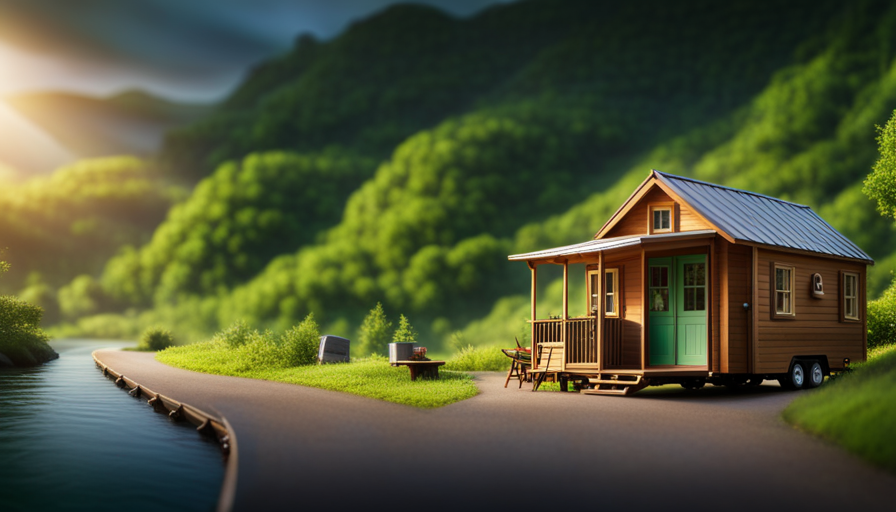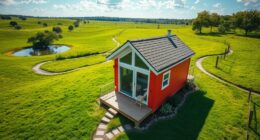Picture a cozy, sustainable retreat tucked away in Maryland. While it may sound like a dream, building your own tiny home in the Free State is more achievable than you think. With thorough research, planning, and determination, you can create a living space that perfectly suits your lifestyle and preferences.
In this article, I will guide you through the step-by-step process of building a tiny house in Maryland. From navigating zoning regulations to designing your floor plan and obtaining the necessary permits, I’ll provide you with all the information you need to make your tiny house dreams a reality.
Whether you choose to work with a professional builder or embark on a DIY project, I’ll help you create a sustainable and eco-friendly home that suits your budget and preferences. So, let’s dive in and get started on your exciting tiny house journey in Maryland!
Key Takeaways
- Thoroughly research zoning regulations in Maryland’s counties and contact local planning and zoning offices for information and requirements.
- Determine budget and explore financing options such as personal loans, home equity loans, or crowdfunding.
- Design the interior to maximize space with multipurpose furniture, built-in storage, and space-saving solutions.
- Gather necessary permits and licenses from the local government before starting construction and ensure compliance with building codes and regulations in Maryland.
Research Zoning Regulations in Maryland
Now, let’s dive into researching the zoning regulations in Maryland so you can confidently build your dream tiny house in this beautiful state! When it comes to building a tiny house, one of the biggest challenges is navigating the zoning regulations.
Each county in Maryland has its own set of rules and regulations regarding the construction and placement of tiny houses. This means that you will need to do some thorough research to ensure that you are in compliance with the local zoning laws.
To begin your research, start by contacting your local planning and zoning office. They’ll be able to provide you with information on the specific requirements for building a tiny house in your area. You can also check the county’s official website, as they often have resources available that outline the zoning regulations.
Additionally, it can be helpful to reach out to local tiny house builders or enthusiasts. They may have already gone through the process of obtaining the necessary permits and can offer guidance or advice based on their own experiences.
By doing thorough research and reaching out to local resources, you’ll be better equipped to navigate the zoning regulations and ensure that you’re building your tiny house in compliance with the laws in Maryland. Once you have a clear understanding of the zoning regulations, you can move on to determining your budget and financing options for your tiny house project.
Determine Your Budget and Financing Options
First off, you’ll want to figure out how much dough you’re willing to dish out and explore those fancy financing options. Budgeting for your tiny house is crucial to ensure that you stay within your means and don’t end up breaking the bank. Let’s take a closer look at some budgeting options and financing alternatives that you can consider.
When it comes to budgeting, it’s important to determine how much you’re willing to spend on your tiny house project. Consider factors such as the size of the house, the materials you plan to use, and any additional features or upgrades you desire. Create a detailed spreadsheet outlining all the costs involved, including land, permits, construction materials, utilities, and even furniture.
Now, let’s dive into financing options. If you have enough savings, you may be able to fund your tiny house project outright. However, if you need additional financial assistance, there are several alternatives to explore. These include personal loans, home equity loans, or even crowdfunding platforms specifically designed for tiny house projects.
By carefully considering your budgeting options and exploring financing alternatives, you can ensure that your tiny house dream becomes a reality without breaking the bank. In the next section, we’ll discuss how to find a suitable location for your tiny house and make your dream home a reality.
| [//]: # (Table) | Budgeting Options | Financing Alternatives |
|---|---|---|
| Savings | Personal Loans | |
| Cost-cutting | Home Equity Loans | |
| Prioritizing | Crowdfunding Platforms | |
| DIY Construction | ||
| Bargain Hunting |
Now that you have a clear understanding of your budget and financing options, let’s move on to finding a suitable location for your tiny house without any hassle.
Find a Suitable Location for Your Tiny House
Consider exploring various locations to park your cozy abode and discover the perfect spot for your tiny house adventure. When looking for suitable locations in Maryland, it’s important to consider zoning regulations that may impact where you can legally place your tiny house.
One option is to look for existing tiny house communities or RV parks that allow tiny houses. These communities often have the necessary infrastructure in place, such as water, sewage, and electricity hookups. They also provide a sense of community and may offer amenities like shared spaces or recreational areas.
Another option is to explore private landowners who are open to renting a space for your tiny house. Make sure to discuss zoning regulations with the landowner and ensure that they’re aware of any restrictions or permits required for your tiny house.
Additionally, you can check with local municipalities to see if they have any specific regulations regarding tiny houses. Some areas may have minimum square footage requirements or restrictions on where tiny houses can be located.
Once you’ve found a suitable location that complies with zoning regulations, you can start designing your tiny house and creating a floor plan, considering the space available and your specific needs.
Design Your Tiny House and Create a Floor Plan
Once you’ve settled on a cozy spot for your compact abode, it’s time to let your creative juices flow and craft a personalized layout for your pint-sized sanctuary. Designing your tiny house interior is all about maximizing space and finding innovative solutions to make the most out of every square inch. Here is a visual representation of ideas that can help you create a functional and stylish floor plan for your tiny house:
| Column 1 | Column 2 |
|---|---|
| Multipurpose furniture | Built-in storage |
| Lofted sleeping area | Foldable dining table |
| Sliding doors | Wall-mounted shelves |
| Open-concept living space | Hideaway kitchen appliances |
| Skylights | Wall-mounted folding desk |
| Mirrors to create an illusion of space | Stairs with built-in drawers |
By incorporating these space-saving solutions, you can optimize the limited square footage of your tiny house. Remember to consider your specific needs and lifestyle when designing your layout. Once you have finalized your floor plan and interior design, it’s time to move on to the next step: gathering the necessary permits and licenses for building your tiny house in Maryland.
Transition Sentence: Now that your tiny house is taking shape, it’s important to gather the necessary permits and licenses to ensure a smooth and legal construction process.
Gather the Necessary Permits and Licenses
Before embarking on the construction of your compact dwelling, it’s crucial to ensure a smooth and legal process by gathering all the necessary permits and licenses. This step is essential to avoid any potential legal issues and ensure that your tiny house meets all the building codes and regulations in Maryland.
To begin, you’ll need to obtain the appropriate permits from the local government. Start by contacting your county’s building department or planning office to inquire about the specific permits required for constructing a tiny house. They’ll provide you with the necessary application forms and guidelines to follow.
Additionally, it’s important to consider financing options for your tiny house project. While building a tiny house can be a cost-effective alternative to traditional housing, it still requires financial planning. Research different financing options such as personal loans, home equity loans, or crowdfunding platforms that specialize in small housing projects.
Once you’ve secured the necessary permits and explored financing options, you can transition into the subsequent section about choosing the right building materials and construction techniques. This next step is crucial in ensuring the longevity and sustainability of your tiny house.
Choose the Right Building Materials and Construction Techniques
To ensure the durability and sustainability of your compact dwelling, it’s crucial that you carefully select the appropriate building materials and construction techniques.
When building a tiny house in Maryland, there are several factors to consider in order to create a comfortable and eco-friendly living space.
Here are five key considerations when choosing building materials and construction techniques for your tiny house:
-
Insulation: Opt for high-quality insulation materials to ensure energy efficiency and a comfortable indoor temperature throughout the year.
-
Sustainable materials: Choose eco-friendly materials such as reclaimed wood, bamboo, or recycled steel for your tiny house construction. These materials not only minimize environmental impact but also add a unique aesthetic appeal.
-
Compact design: Incorporate efficient space-saving features and storage solutions into your design to maximize the usable area within the limited square footage.
-
Energy-efficient windows and doors: Install double-pane windows and well-insulated doors to minimize heat loss and reduce energy consumption.
-
Lightweight construction: Consider lightweight construction techniques such as using steel frames or SIPs (structural insulated panels) to ensure the structural integrity of your tiny house while keeping the overall weight manageable.
By carefully selecting the right building materials and construction techniques, you can create a durable, sustainable, and comfortable tiny house in Maryland. Once you have these elements in mind, you can move on to the next step of your tiny house journey: working with a professional builder or embarking on a DIY project.
Work with a Professional Builder or DIY
Consider collaborating with an experienced builder or taking on a DIY project to further enhance the intricacy and craftsmanship of your compact dwelling. Working with a professional builder has several benefits. They have the expertise and knowledge to ensure that your tiny house is built to code and meets all legal requirements. They can also provide guidance on choosing the right materials and construction techniques, ensuring that your tiny house is durable and long-lasting. Additionally, a professional builder can help you navigate any challenges that may arise during the construction process, saving you time and stress.
On the other hand, taking on a DIY project can be a rewarding experience. It allows you to have full control over the design and construction of your tiny house. However, there are also challenges that come with DIY. It requires a significant amount of time, effort, and skill. You’ll need to research and learn about building codes, permits, and regulations. You’ll also need to have a good understanding of construction techniques and be comfortable working with tools. DIY can be a cost-effective option, but it’s important to be realistic about your abilities and the time commitment involved.
In the next section, we will discuss how to install utilities and ensure off-grid capabilities for your tiny house.
Install Utilities and Ensure Off-Grid Capabilities
One option for enhancing the functionality of your compact dwelling is by exploring the installation of utilities and off-grid capabilities.
When it comes to powering your tiny house off the grid, there are several off-grid power sources to consider. Solar panels are a popular choice, as they harness the power of the sun to provide electricity. Wind turbines can also be used to generate power, especially in areas with consistent wind patterns. Another option is a generator, which can be used as a backup power source.
In addition to power, water conservation methods are essential for a tiny house. Installing a rainwater harvesting system allows you to collect and store rainwater for various uses, such as flushing toilets or watering plants. Low-flow fixtures and water-saving appliances can also help minimize water usage.
By implementing these off-grid power sources and water conservation methods, you can make your tiny house more self-sufficient and environmentally friendly.
In the next section, we will consider sustainable and eco-friendly features to further enhance your tiny house.
Consider Sustainable and Eco-Friendly Features
Enhance your compact dwelling with sustainable and eco-friendly features that will transform your tiny house into an environmentally conscious oasis. When building a tiny house in Maryland, it’s important to consider sustainable materials that minimize your ecological footprint. Opt for materials such as reclaimed wood, bamboo, or recycled metal. These materials are not only environmentally friendly but also add a unique touch to your tiny house’s aesthetic.
Additionally, use non-toxic paints and finishes to help maintain excellent indoor air quality.
Incorporating energy-efficient appliances is another crucial aspect of creating an eco-friendly tiny house. Choose appliances with high energy star ratings to reduce electricity consumption. Energy-efficient options include compact refrigerators, tankless water heaters, and low-flow faucets and toilets.
Investing in solar panels can also significantly reduce your reliance on the grid and decrease your monthly utility bills.
By utilizing sustainable materials and energy-efficient appliances, you can create a tiny house that’s both environmentally friendly and comfortable. Live a more sustainable lifestyle while enjoying the benefits of a smaller, more efficient living space. Embrace the simplicity and freedom that comes with owning a tiny house in Maryland and discover the joy of living with less.
Enjoy Your New Tiny House Lifestyle in Maryland!
After considering sustainable and eco-friendly features for your tiny house in Maryland, it’s time to delve into the exciting prospect of enjoying your new tiny house lifestyle in the state.
Maryland offers a vibrant and welcoming tiny house community, where like-minded individuals come together to share their passion for simple living and sustainable practices.
One of the first steps to enjoying your tiny house lifestyle in Maryland is to familiarize yourself with the tiny house regulations in other states. While Maryland doesn’t have specific regulations for tiny houses yet, looking at regulations in other states can provide valuable insights and help you navigate the process. Each state has its own set of guidelines, so it’s important to research and understand the rules and regulations that may apply to your tiny house.
Additionally, connecting with the tiny house community in Maryland can be immensely beneficial. Joining local groups and attending events can provide valuable resources, support, and inspiration as you embark on your tiny house journey. You’ll have the opportunity to meet fellow tiny house enthusiasts, learn from their experiences, and share your own insights.
By considering sustainable features and embracing the tiny house community in Maryland, you can truly enjoy the unique and fulfilling lifestyle that a tiny house offers.
Frequently Asked Questions
How can I legally live in a tiny house in Maryland?
To legally live in a tiny house in Maryland, I’ve found it beneficial to explore living off-grid and financing options. Living off-grid allows you to be self-sufficient with water, power, and waste management. Financing options include personal savings, loans, or even partnering with a tiny house builder.
Additionally, it’s important to research local zoning laws and building codes to ensure compliance. Proper planning and understanding of these factors will help you navigate the process successfully.
Are there any specific size requirements for tiny houses in Maryland?
There are specific size requirements for tiny houses in Maryland. The state doesn’t have a minimum size requirement, but there are maximum limits to consider. According to the International Residential Code (IRC), a tiny house on wheels shouldn’t exceed 400 square feet.
Additionally, it’s important to comply with local zoning regulations and obtain necessary permits. It’s advisable to consult with local authorities and professionals to ensure compliance with all regulations and requirements.
What are the zoning regulations for tiny houses in Maryland?
Living in a tiny house in Maryland offers a plethora of benefits. The picturesque tiny house communities provide a sense of community and a chance to live a simpler, more sustainable lifestyle. However, it’s important to consider the zoning regulations before embarking on this adventure.
In Maryland, zoning regulations vary by county and it’s crucial to research the specific rules and requirements in your desired location. By familiarizing yourself with these regulations, you can ensure a smooth process when building your tiny house in Maryland.
Can I park my tiny house on my own property in Maryland?
Yes, you can park your tiny house on your own property in Maryland, but there are some parking restrictions to be aware of.
Before you start, check your local zoning regulations to ensure that your property allows for tiny house parking. Additionally, some neighborhoods or homeowners associations may have restrictions on parking tiny houses.
If you prefer to live in a community, you can also explore tiny house communities in Maryland that provide designated parking spaces for tiny homes.
Are there any specific building codes or regulations I need to follow when constructing a tiny house in Maryland?
Building a tiny house in Maryland requires careful consideration of building codes and permits. In fact, these regulations act as the foundation of your tiny house project, much like a strong base supports a sturdy structure.
Maryland has specific building codes that govern the construction of tiny houses, ensuring safety and compliance with zoning laws. It’s essential to research and understand these regulations before embarking on your tiny house journey to avoid any legal issues down the road.
Conclusion
Wow, building a tiny house in Maryland is quite the adventure! I’ve researched zoning regulations, determined my budget, and found the perfect location.
Designing my tiny house was so much fun, and now I have a detailed floor plan to work with. I made sure to gather all the necessary permits and licenses, and I’m ready to start building.
Whether I choose to work with a professional or go the DIY route, I know this journey will be worth it. Once my tiny house is complete, I’ll enjoy a sustainable and eco-friendly lifestyle in Maryland that’s truly out of this world!
Hi, I’m Emma. I’m the Editor in Chief of Tiny House 43, a blog all about tiny houses. While tree houses are often associated with childhood, they can be the perfect adult retreat. They offer a cozy space to relax and unwind, surrounded by nature. And since they’re typically built on stilts or raised platforms, they offer stunning views that traditional homes simply can’t match. If you’re looking for a unique and romantic getaway, a tree house tiny house might just be the perfect option.
